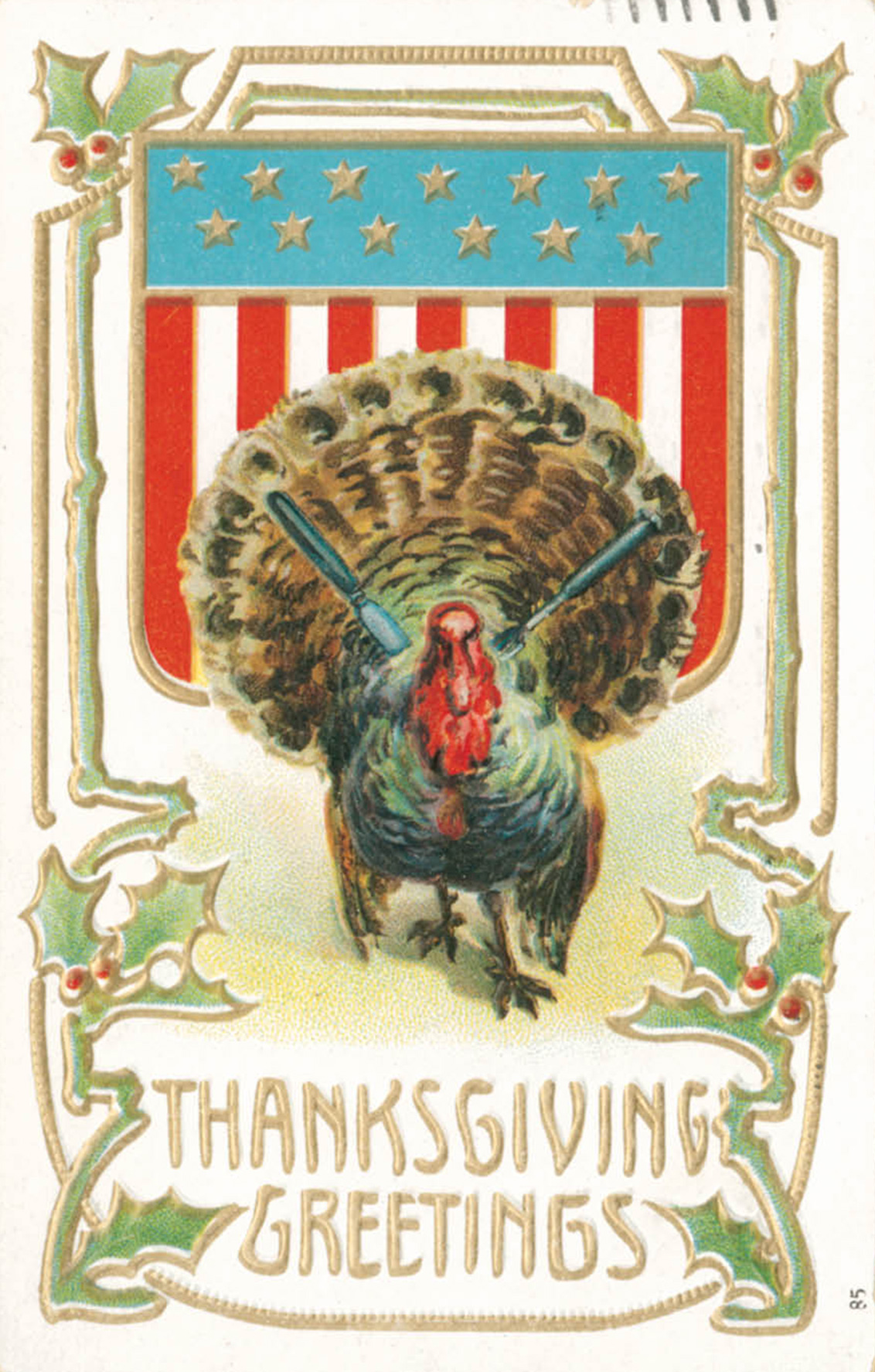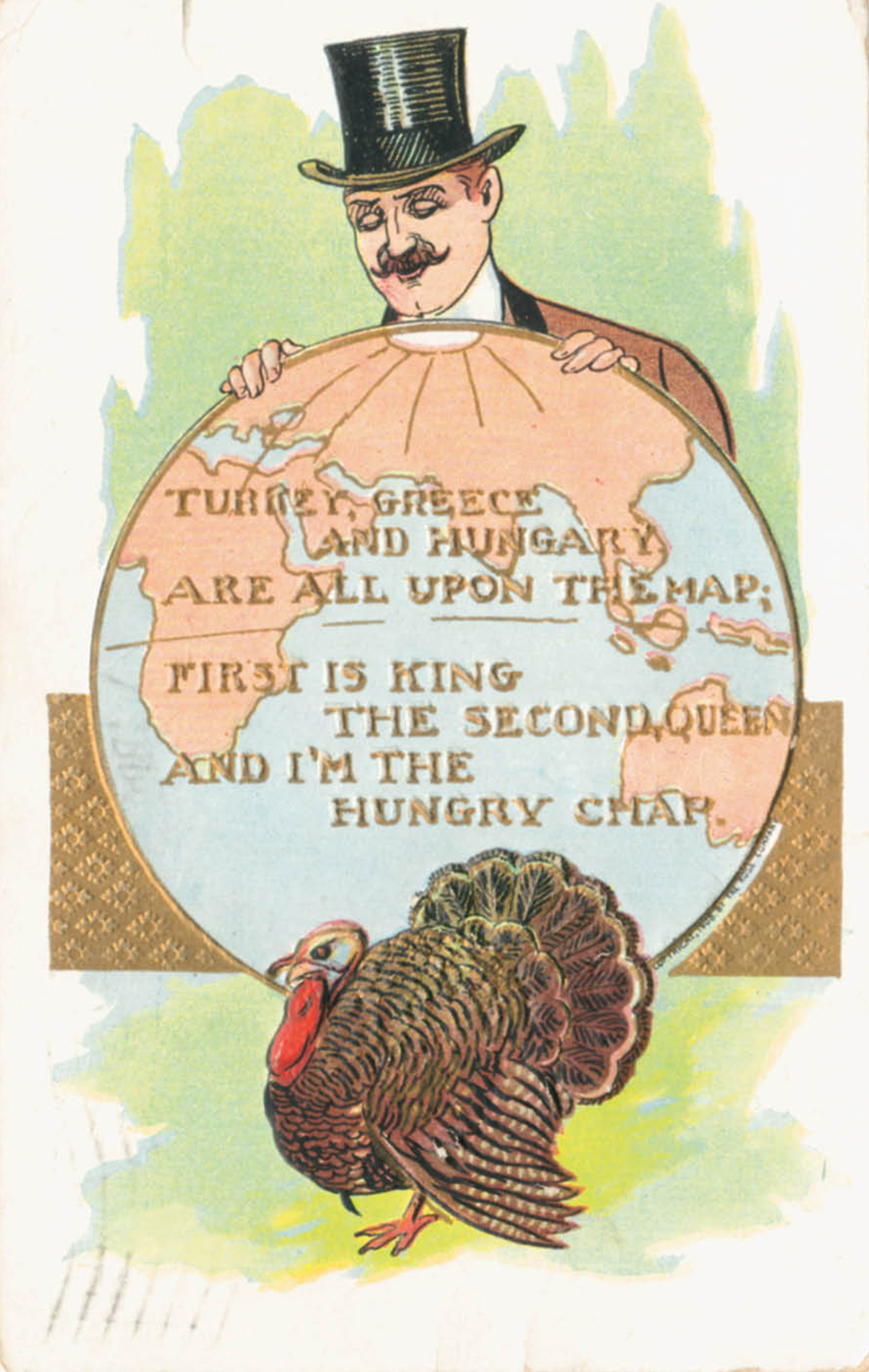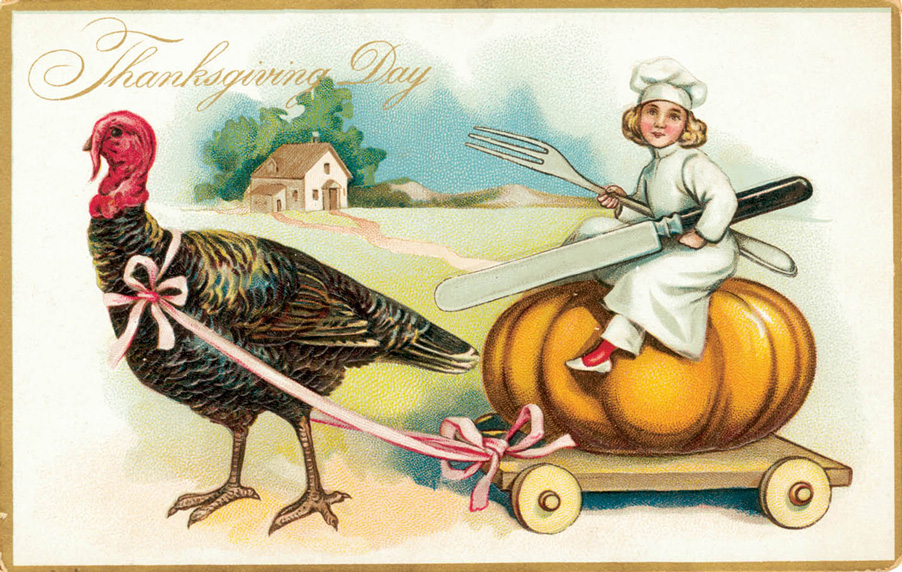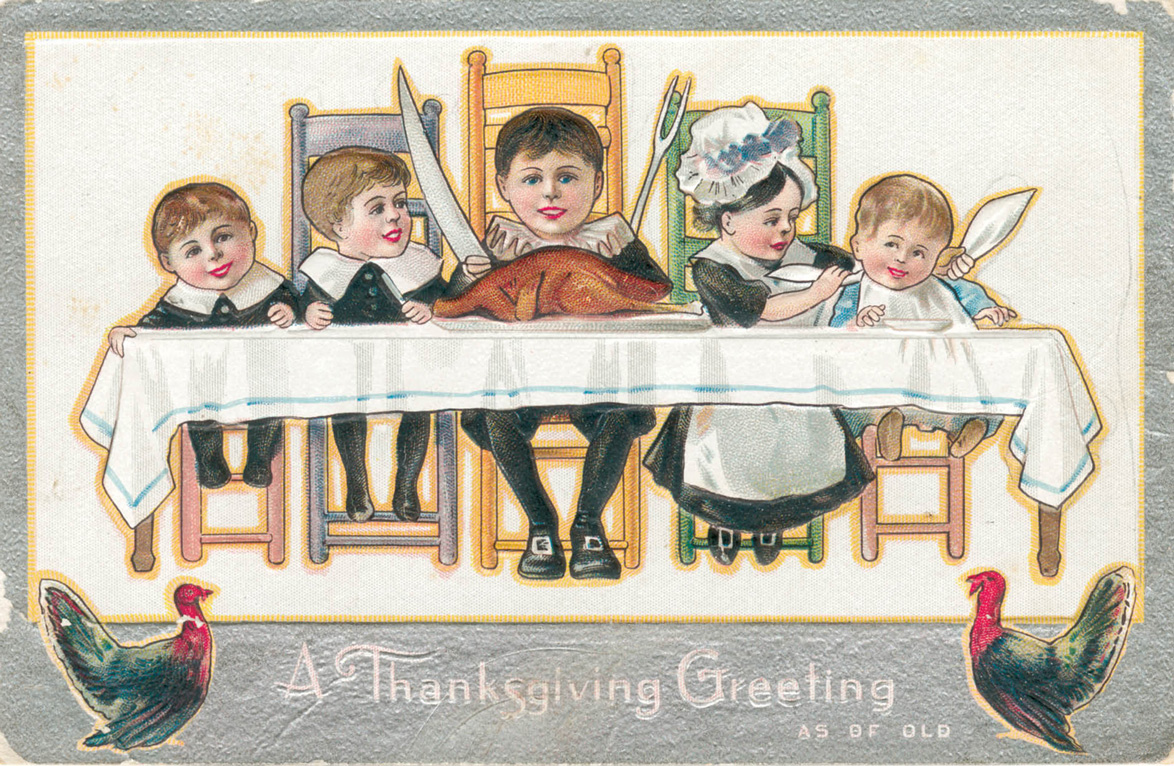Ingestion / Talking Turkey
Andrew F. Smith on the reluctant star of Thanksgiving
Jeffrey Kastner
“Ingestion” is a column that explores food within a framework informed by aesthetics, history, and philosophy.
From deli sandwich standby to familiar symbol of the American Thanksgiving holiday, the turkey’s current-day culinary ubiquity is actually the product of a remarkable geographic and economic odyssey, one that in many ways parallels the exploration and settlement of its New World home. In his new book, The Turkey: An American Story, food historian Andrew F. Smith traces this history—from the conquistadors’ first contact with the bird in Mexico and its rapid adoption as a food throughout Europe to the turkey’s return, via the first settlers in America, to its native land, where it would eventually become the celebrated centerpiece of a new national holiday. Jeffrey Kastner spoke to Smith by telephone in June 2006.

Cabinet: Your book starts with a distinction between the only two turkey species that survived from prehistoric times—the ocellated turkey and the common turkey. Which one became the domesticated turkey we know today?
Andrew F. Smith: The ocellated turkey thrives only in Honduras, Guatemala, and Southern Mexico—it’s a very narrow range—and despite repeated attempts, it has never been domesticated. The larger group is the common turkey—Meleagris gallopavo—which includes six different varieties in the United States and Mexico and Canada today, and from two of these varieties the domesticated turkey emerged.
Let’s talk about domestication. You note that there’s some archeological evidence of turkey domestication quite early on in Mesoamerica.
The archeological record isn’t good enough to draw any clear conclusions. You look at the bones of wild and domesticated turkeys and they’re almost exactly the same. Now if feathers survive, then you can get some indication of domestication: if they’re white-tipped, the birds most likely were fed a diet of corn, and corn doesn’t grow in the wild—so you know there is some connection between these particular turkeys and humans. If you have eggshells nearby, that can indicate domestication. It looks as if the turkey was domesticated twice—in what is now Mexico and in what is now the American Southwest.
These pre-Columbian domestications occurred in the first few centuries AD. What happens between then and when the Europeans arrive?
We do have archeological evidence of wild turkeys in North America beyond the American Southwest and they go back several thousand years. We know the wild turkey was part of the diet of Mesoamerica and in North America many Indian groups ate turkey. At the same time, some tribes like the Pima, the Papago, the Cheyenne, and the Hopi quite emphatically refused to eat turkeys, though the Hopi considered their eggs a delicacy and turkey bones and feathers were frequently used in religious ceremonies.
So how did the turkey get to Europe?
European explorers had no common way of describing or naming New World plants and animals, so when you’re examining early records of voyages, you’re never exactly sure what is being described. And there’s a linguistic problem with the turkey. In most European languages, it was named after the peafowl. In English, the word turkey itself appears before 1492, but it most likely refers to the Guinea fowl, which originated in West Africa. The peafowl, the Guinea fowl, and the turkey are all very closely related genetically, so it is understandable that they would be confused, but it is very difficult examining the record to determine when the turkey really arrived in Europe. That said, the most likely answer to the question is that the Spanish brought turkeys back to Spain and Italy after Cortés’s invasion of Mexico in 1519.
And you mention that the root “turk” was in some sense synonymous with “exotic.”
Yes. Fifteenth- and sixteenth-century Turkey controlled all of Northern Africa and it is quite possible that the Guinea fowl could have come through the Eastern Mediterranean and been named after the Turks. But it’s only the English that called them that. So the answer is there’s no good answer, other than to say the word turkey referred to both the Guinea fowl and what we think of as the turkey today. And from descriptions alone, it’s almost impossible to tell them apart—all these birds are part of the pheasant family, and these two birds were in England at the same time. The turkey is a larger bird that’s much easier to raise—it requires virtually no care at all—and it tastes better.
I had always understood that New World foods took centuries to be adopted in the Old World, but this wasn’t the case with the turkey. Within a matter of twenty years of the Spanish encounter with the turkey, it was a common part of the European food system—that is an incredibly short period of time. Part of the reason was the existing cultural vision of the peacock, which was the iconic food of Europe at the time. It was a gorgeous bird: eating them was about show and a demonstration of wealth. I don’t know if you’ve ever eaten peacock, but it tastes terrible, even by sixteenth-century standards. The turkey arrives in Europe and spreads its feathers. It’s not as gorgeous as the peacock, but it will do in a pinch, and it tastes so much better. And turkeys are prolific—hens lay twelve to thirty eggs in a season, so if you’ve got twenty turkeys around, you can have thousands in a matter of years.

Weren’t they, in fact, originally brought back as show birds rather than for eating?
In the first recorded instance of the turkey in Italy, for example, we have someone saying, “This is for looks, don’t eat it!” But obviously people knew what to do with the turkeys when they became plentiful. They were assimilated quickly as a foodstuff, not just in Europe, but also in Asia, India, and China.
You’ve mentioned how rapidly the turkey spread around the rest of the world, but how did the domesticated turkey make its way back to the US? Were early European settlers in America looking to domesticate turkeys when they arrived here? Did Eastern Native American tribes have domesticated turkeys when Europeans came to America in the late sixteenth and early seventeenth century?
The consumption of turkeys was already well-established in England before the first English settlements in the US, and the settlers brought domesticated turkeys with them. But the settlers’ turkeys weren’t really any great shakes—for one thing, they were a lot smaller than the wild turkeys of the day. You find descriptions of wild turkeys at forty to sixty pounds, and I believe them. The people who made those observations were professionals who accurately described a lot of other things, and there’s no reason why turkeys wouldn’t be that fat—they don’t really have any natural enemies. So, obviously, settlers preferred wild turkeys, and they were so plentiful. There were millions in the woodlands of Eastern North America, in the river valleys of the Midwest and Ohio, in Texas and the Southwest. And wild turkeys were so easy to catch. You could do it with dogs and horses—you didn’t even need a gun, you could catch them with a noose or a net.
That doesn’t produce much incentive to raise domesticated turkeys. When does that begin in the colonies?
As soon as colonists exhausted the wild supply, when they killed them all off! And, of course, the slaughter was incredible. If you look at the records in Massachusetts, for example, there were wild turkeys everywhere—and within fewer than seventy years of the European settlement, observers are asking, “Where did all the turkeys go?” And as time goes on, the domesticated turkey gains in weight so that by around 1750, domesticated turkeys and the dwindling number of wild turkeys that are left are pretty much the same size. And the domesticated turkeys are just easier at that point; you just pen them up and they eat anything.
Can you talk about the growing role of the turkey in social dining settings? You note that only a few decades after becoming established in England, it’s already become a ubiquitous part of Christmas dinner there.
Well, the turkey competed with the goose, which had historically been the traditional bird for the English Christmas holiday season. But all of a sudden you have farmers, at least in the rural areas, saying, “Oh yeah, I’ve got lots of turkeys here!” In urban areas, like London, I suspect that turkey would still have been somewhat expensive, but if you look at the figures, turkey cost less than chicken did, particularly at the time of year when there was a glut in the market—in the autumn. Then, as now, turkey was the least expensive meat per pound.
So it had established itself as a Christmas dish, but we now associate it almost exclusively with the American holiday of Thanksgiving. How did that happen?
The Puritans had days of thanksgiving; that was an English tradition. These were days specifically set aside to be spent in church, in prayer. There’s very little evidence that in Colonial America anyone ever associated a large dinner with these thanksgivings. That began to change after the American Revolution, when the dinner became the focal point. I don’t have a good reason for the shift, other than the breakdown of religious practices and the desire of New Englanders to have a holiday to celebrate in the fall. Sarah Josepha Hale—a New Hampshire schoolteacher whose first claim to fame was the poem “Mary Had A Little Lamb,” which she wrote in the 1820s—comes along and decides that everyone in America should celebrate Thanksgiving and she begins campaigning for it. In her 1827 anti-slavery novel, Northwood, she has a full chapter on Thanksgiving and the turkey plays a prominent role. And eventually, after seventeen years of vocal advocacy, she finally convinces President Lincoln to establish this new national holiday, which he does officially in the summer of 1863, following the horrific battles at Gettysburg and Vicksburg. And look at the holiday she creates! A feminized, domestic day, where women are the stars—it’s not religious or patriotic, though it has characteristics of both. Instead it’s really a family holiday, a time for people to come together in the household around a feast featuring a turkey.

How did this family holiday get bound up with the classic story about the Pilgrims and the Indians?
The Pilgrims were not actually associated with thanksgiving feasts until 1841, when a letter from a fellow named Edward Winslow was discovered. Winslow was one of the Pilgrims and the letter, which he wrote to some friends in England in 1621, says, “Oh, by the way, we had a wonderful event in the fall when, after the harvest was in, we started firing our muskets for practice and the Indians came over and they brought some venison and we had a nice time.” There was no mention of “thanksgiving” in Winslow’s letter, and indeed the Puritans would not have considered it such a day. But when the letter was published in 1841, the commentary about this section of the letter proclaimed the event to be “America’s First Thanksgiving!” This myth was promoted mainly in New England until after the Civil War.
Toward the end of the nineteenth century, immigrants poured into America and education became one way of assimilating the new arrivals. The nation needed a simplified history that everyone could understand. So an origin myth was created that cast the Pilgrims as the founders of America, and Thanksgiving became part of the myth. This is a bit humorous given that Jamestown, Virginia, had been founded well before the Pilgrims even thought about leaving Holland. However, by the Civil War, the community of Jamestown had been abandoned and much of it had been swallowed by the James River. But the real problem was slavery, which began in Jamestown. By contrast, the Pilgrims were a good, religious group who initially had good relationships with the American Indians. And, of course, the South lost the Civil War, and the North dominated textbook production, so the origin myth of the Pilgrims founding America and of the first Thanksgiving ended up in the schoolbooks.
When does turkey farming begin to evolve into the huge business we see today?
Though larger-scale chicken farming was already going on in the late nineteenth century, women and children still mainly raised turkeys on farms and it’s not really until the 1920s that turkey farming becomes a bigger business—that’s when you have the experimental agricultural stations that are trying to figure out how to solve the problems associated with raising turkeys in confinement on a large scale. And of course, you had a big problem expanding the turkey market: people really only ate it once or maybe twice a year. So in fact turkey doesn’t become what you might call an industrial product until just before World War II with the shift toward the so-called broad-breasted turkey. And as for successful attempts to solve the problem of getting people to eat turkey all year long, that doesn’t occur until we get products like turkey bacon and ground turkey burgers in the 1980s.
What is the broad-breasted turkey?
The broad-breasted turkey was a genetic mutation that was an American bronze turkey crossed with a domesticated turkey in England. It ended up with a very large breast. It was brought to Canada in the early twentieth century by an Englishman named Jesse Throssel, who displayed his large birds at turkey exhibitions in the United States. It was a startling bird that was immediately acquired by several breeders, who really had to work on it—one big problem was that the male birds had unusually short legs and couldn’t fertilize the hens, and so they began to develop modes of artificial insemination, which they finally figured out how to do economically in the 1930s. And they wanted a bird that could mature quickly, so they crossed it with a white turkey strain, ending up with today’s broad-breasted white turkeys. Now producing a larger, heavier bird seems obvious, but prior to the arrival of the broad-breasted strains, breeders were mainly interested in the color of the birds’ feathers.
Is this a hangover from that old notion of the turkey as a kind of show bird?
I think so. Farmers wanted a turkey that looked good. At that point, everyone sold turkeys on a per piece basis rather than by the pound, so you demonstrated your skill as a farmer by the perfection of the feathers your birds had. In any case, taste was not a factor in breeding and for a very good reason, which is that Americans do not like a strong taste in poultry. No one cared that they were bland tasting—after all, part of how Americans eat turkey is with a lot of other things served on it, like gravy and stuffing and cranberry sauce. So the turkey is really meant to be a kind of neutral platform to convey whatever flavors consumers like. Some people say turkeys don’t taste good anymore, but the fact is that Americans generally don’t care.

My favorite anecdote in the book was the story of the great twentieth-century turkey magnate, Carl Swanson, and the birth of the ubiquitous turkey TV dinner.
Swanson was an immigrant who came to the US in 1896. During the Depression, he decided there was money to be made in turkeys. He went to farmers and made a deal with them—at the beginning of the season, he’d agree to buy x number of turkeys at the end of the season at a set price, so farmers were guaranteed a certain income. At the time, demand for turkey was increasing because of its low cost and, during World War II, because of the scarcity of other kinds of meat, so the system worked extremely well.
After the war, Swanson decided to go one step further—he would try to corner the turkey market so he could sell turkeys at a higher price, so he went about the country signing contracts with many major raisers. The problem was that any farmer can raise turkeys, and as the price for turkeys increased, other farmers got into the business, too. In 1951, there was a glut of turkeys on the market and Swanson ended up with a lot of surplus birds that he had to buy. He decided to keep them frozen until he could figure out what to do. He had twenty refrigerated train cars just going around the country, each filled with over 50,000 pounds of frozen turkey. It turned out that one of his employees had just visited a company that made food for Pan Am Airlines and had created an aluminum tray to be heated up in airplanes on trans-Atlantic flights. At that time, frozen food was a minor product in American grocery stores because most Americans didn’t have freezers in their homes. That began to change at the end of the 1940s, when every refrigerator sold had a nice-sized freezer in it. Swanson’s real brainstorm was to connect his frozen turkey dinner to the TV, which was very much the “in” technology. People loved the idea that you could sit with your dinner on a tray and watch TV, but oddly enough, there was no thought of that at all on the part of the creators—they called it a “TV dinner” because the container looked like a television. There had been frozen chicken and turkey pies before that time, so it wasn’t a totally new technology but this was extremely successful—selling millions of frozen meals annually. It wasn’t just a pie, it was a whole dinner, and included the sides, dressing, gravy, and, of course, the turkey.
Jeffrey Kastner is an independent writer and senior editor of Cabinet. He lives in Brooklyn, New York.
Spotted an error? Email us at corrections at cabinetmagazine dot org.
If you’ve enjoyed the free articles that we offer on our site, please consider subscribing to our nonprofit magazine. You get twelve online issues and unlimited access to all our archives.